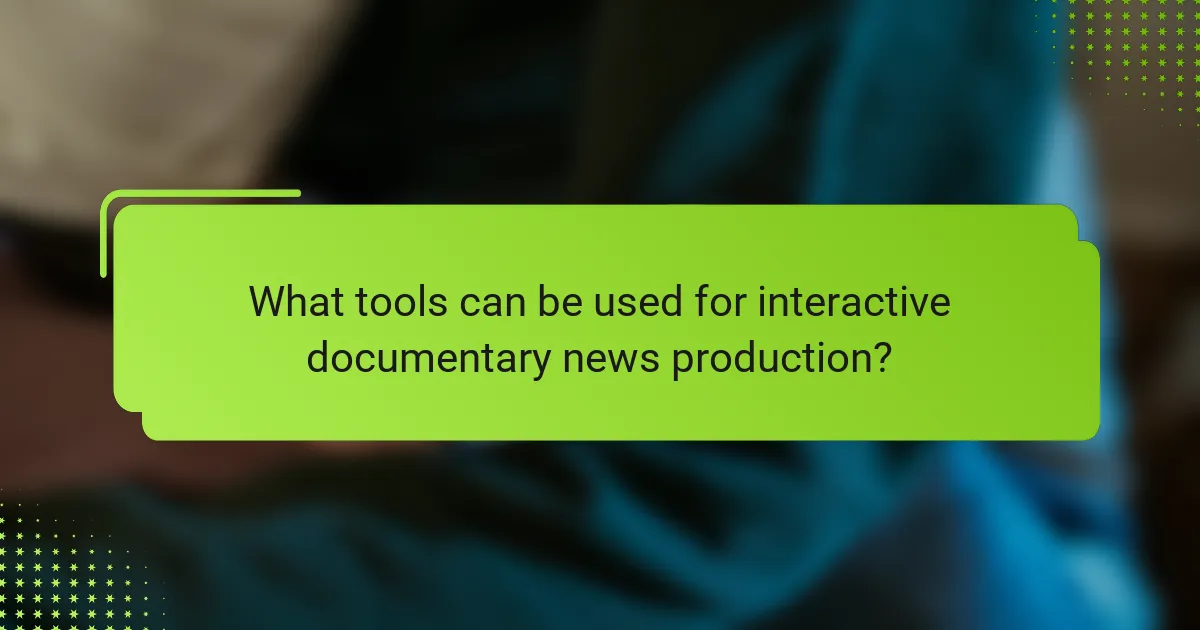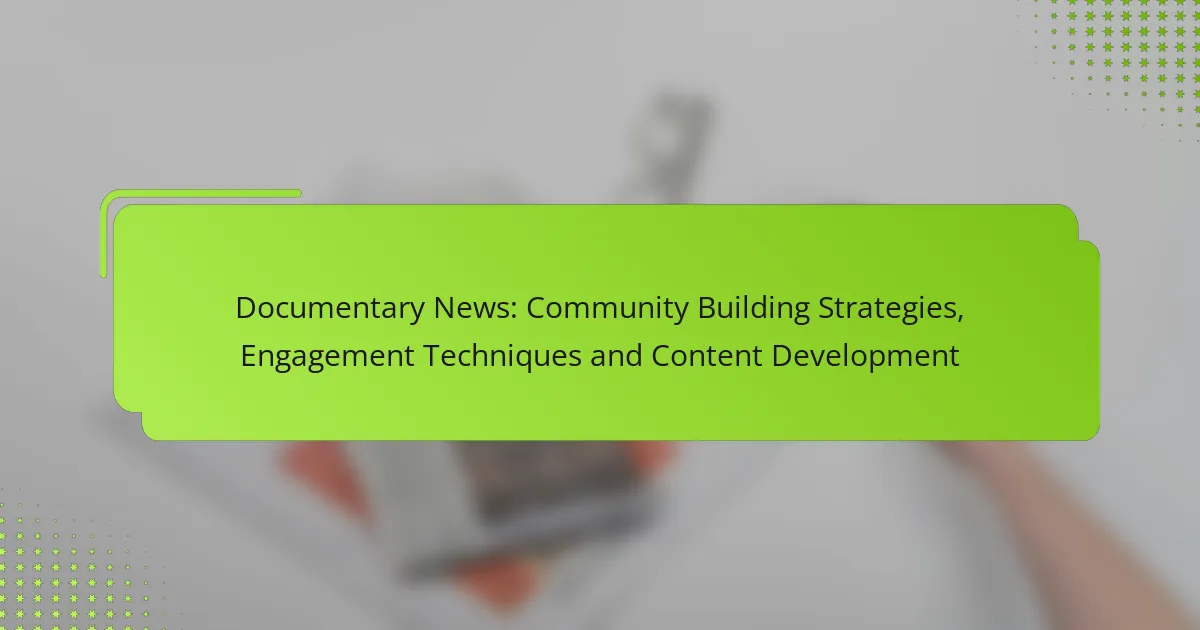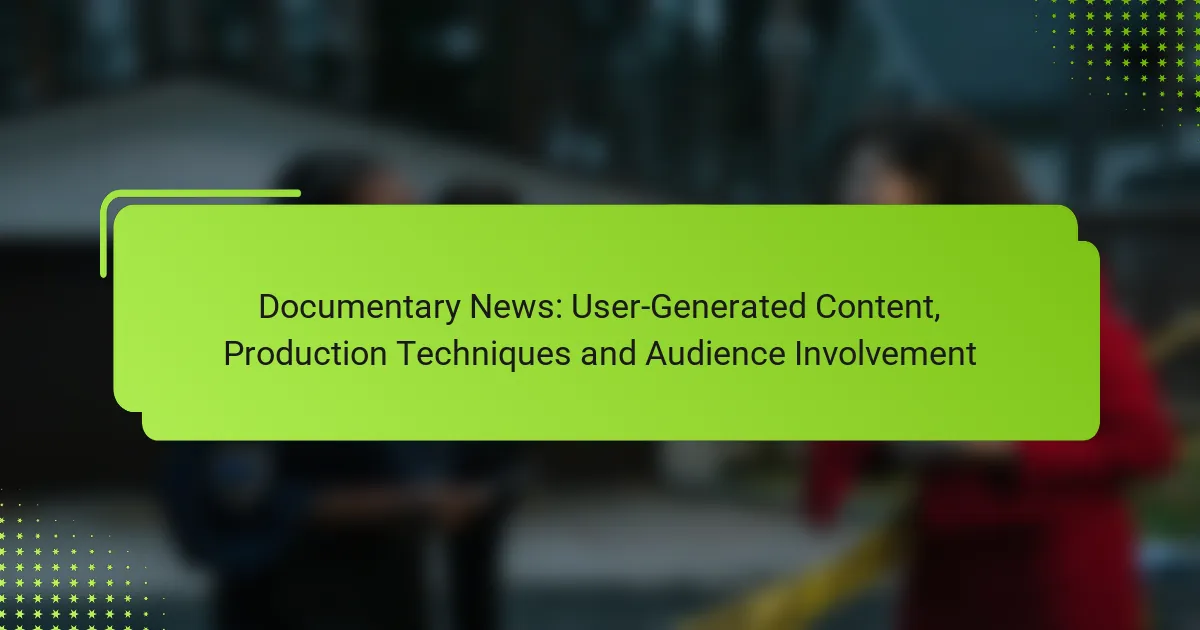Interactive elements are transforming documentary news by enhancing viewer engagement and participation. By integrating features such as polls, user-generated content, and immersive experiences, documentaries can create a more personalized and impactful viewing journey. This focus on audience interaction not only enriches the viewer experience but also fosters emotional connections and improves retention rates.

How can interactive elements enhance documentary news in the US?
Interactive elements can significantly enhance documentary news in the US by fostering deeper engagement and participation from viewers. By incorporating features that allow audiences to interact with content, documentaries can create a more immersive and personalized viewing experience.
Increased viewer participation
Incorporating interactive elements encourages viewers to actively participate in the documentary experience. This can include features like polls, quizzes, or decision-making scenarios that allow audiences to influence the narrative or share their opinions. Such engagement not only keeps viewers interested but also makes them feel like a part of the story.
For instance, a documentary about climate change might include a poll asking viewers to choose which solutions they believe are most effective. This not only gathers viewer input but can also guide future content based on audience preferences.
Real-time feedback mechanisms
Real-time feedback mechanisms allow viewers to share their thoughts and reactions as they watch. This can be achieved through live chat features or comment sections where audiences can discuss the content instantly. Such feedback can provide valuable insights for producers about viewer perceptions and interests.
For example, during a live-streamed documentary screening, viewers could submit questions that the filmmakers address in real-time, creating a dynamic dialogue that enhances the viewing experience.
Enhanced storytelling through multimedia
Multimedia elements such as videos, infographics, and interactive maps can significantly enhance storytelling in documentary news. By integrating various media formats, producers can present complex information in more digestible and engaging ways. This approach caters to different learning styles and keeps the audience captivated.
A documentary on urban development might use interactive maps to show changes over time, allowing viewers to explore specific neighborhoods and their transformations. This not only informs but also invites exploration and curiosity.
Gamification of content
Gamification involves applying game-like elements to non-game contexts, which can make documentary news more engaging. By incorporating challenges, rewards, or progress tracking, producers can motivate viewers to interact with the content more deeply.
For instance, a documentary series could offer badges for completing episodes or quizzes related to the content, encouraging viewers to engage with all parts of the series and share their achievements on social media.
Use of social media integration
Integrating social media into documentary news allows for broader audience engagement and sharing. Viewers can share their thoughts, reactions, and favorite moments on platforms like Twitter, Facebook, or Instagram, creating a community around the content.
Producers can also use social media to promote discussions, host live Q&A sessions, or encourage viewers to share their own stories related to the documentary’s themes. This not only amplifies reach but also enriches the viewer experience by connecting them with others who share similar interests.

What are the best practices for audience engagement in documentary news?
Effective audience engagement in documentary news involves interactive elements that foster participation and enhance viewer experience. Best practices include utilizing polls and surveys, incorporating user-generated content, creating immersive experiences, and leveraging live Q&A sessions.
Utilizing polls and surveys
Polls and surveys are powerful tools for engaging audiences by allowing them to express their opinions and preferences. They can be integrated into online platforms or social media channels, providing immediate feedback on topics related to the documentary.
When designing polls, keep questions clear and concise, and consider using multiple-choice formats for ease of participation. Regularly sharing results can also encourage further engagement and discussion among viewers.
Incorporating user-generated content
User-generated content (UGC) invites audiences to contribute their own stories, photos, or videos related to the documentary’s theme. This approach not only enriches the narrative but also fosters a sense of community among viewers.
Encourage submissions through social media hashtags or dedicated platforms, ensuring that guidelines are clear to maintain quality. Highlighting selected contributions in the documentary or on associated websites can motivate more viewers to participate.
Creating immersive experiences
Immersive experiences can significantly enhance audience engagement by allowing viewers to interact with the content in innovative ways. This can include virtual reality (VR) experiences, interactive maps, or multimedia storytelling that deepens understanding of the documentary’s subject.
Consider the technical requirements and accessibility of these experiences to ensure a broad audience can participate. Providing a mix of formats can cater to different preferences and enhance overall viewer satisfaction.
Leveraging live Q&A sessions
Live Q&A sessions create a dynamic platform for audiences to engage directly with filmmakers, experts, or subjects featured in the documentary. These sessions can be hosted on social media or streaming platforms, allowing real-time interaction.
Promote the sessions in advance to build anticipation and encourage participation. Prepare a mix of questions to guide the discussion while also allowing audience members to submit their inquiries, ensuring a diverse range of topics is covered.

How does viewer experience impact documentary news consumption?
The viewer experience significantly influences how audiences consume documentary news, affecting their engagement and retention. A positive experience can lead to higher retention rates, emotional connections, and accessibility for diverse audiences.
Influence on retention rates
Retention rates in documentary news are closely tied to viewer experience. Engaging narratives, interactive elements, and high-quality visuals can keep viewers watching longer, often translating to increased information retention. For instance, documentaries that incorporate quizzes or polls may see retention rates improve by several percentage points compared to traditional formats.
To enhance retention, producers should focus on creating compelling openings and maintaining a steady pace throughout the documentary. Keeping the content concise and relevant helps maintain viewer interest, especially in a fast-paced media landscape.
Effects on emotional connection
The emotional connection viewers feel towards documentary news is crucial for fostering empathy and understanding. Documentaries that effectively use storytelling techniques, such as personal narratives or relatable characters, can evoke stronger emotional responses. This connection often leads to a greater willingness to engage with the content and share it with others.
Producers should consider incorporating real-life stories and testimonials to enhance emotional engagement. Using music and visuals that resonate with the audience can also amplify emotional responses, making the content more memorable and impactful.
Role of accessibility features
Accessibility features play a vital role in ensuring that documentary news reaches a broader audience. Subtitles, audio descriptions, and sign language interpretation can significantly enhance the viewer experience for individuals with disabilities. By making content accessible, producers can increase viewership and foster inclusivity.
To effectively implement accessibility features, producers should follow established guidelines, such as the Web Content Accessibility Guidelines (WCAG). Regularly testing content with diverse user groups can help identify areas for improvement, ensuring that all viewers can engage with the documentary news effectively.

What tools can be used for interactive documentary news production?
Interactive documentary news production can leverage various tools that enhance audience engagement and viewer experience. These tools allow creators to incorporate multimedia elements, interactive features, and immersive storytelling techniques.
Adobe Spark for multimedia content
Adobe Spark is a user-friendly platform that enables creators to produce visually appealing multimedia content. It allows for the integration of images, videos, and text, making it ideal for crafting engaging stories that captivate viewers.
When using Adobe Spark, consider its templates and design options to maintain a consistent visual style. This can enhance the overall viewer experience by providing a polished and professional look to your interactive documentary.
ThingLink for interactive images
ThingLink is a powerful tool for creating interactive images that can enrich documentary narratives. Users can add clickable hotspots to images, linking to videos, audio clips, or additional information, which encourages deeper exploration of the content.
To maximize the impact of ThingLink, focus on high-quality images and relevant hotspots that enhance the storytelling. This approach can significantly increase viewer engagement and retention of information.
H5P for creating interactive videos
H5P is an open-source tool that allows users to create interactive videos with quizzes, polls, and other engaging elements. This interactivity can transform a passive viewing experience into an active learning opportunity, making it suitable for educational documentary news.
When using H5P, ensure that the interactive elements are seamlessly integrated into the video flow. This helps maintain viewer interest and encourages participation, which can lead to better comprehension of the documentary’s themes.

What metrics should be used to measure audience engagement?
To effectively measure audience engagement, consider metrics that reflect viewer interaction and retention. Key metrics include view duration, social media engagement rates, and feedback from surveys, all of which provide insights into how audiences connect with documentary content.
View duration statistics
View duration statistics indicate how long viewers stay engaged with a documentary. This metric is crucial as it helps identify which segments retain attention and which may cause drop-offs. Aim for an average view duration that is a significant portion of the total runtime, ideally above 50% for optimal engagement.
To analyze this metric effectively, use analytics tools that track viewer behavior over time. Look for patterns in view duration across different demographics to tailor content that resonates with specific audience segments.
Engagement rates on social media
Engagement rates on social media reflect how audiences interact with documentary content through likes, shares, comments, and mentions. High engagement rates indicate that the content resonates with viewers, prompting them to discuss and share it within their networks. Aim for engagement rates in the low to mid double digits as a benchmark for success.
Utilize social media analytics tools to track these metrics, and consider running targeted campaigns to boost engagement. Engaging with viewers through comments and discussions can further enhance these rates and foster a community around the documentary.
Feedback and survey results
Feedback and survey results provide direct insights into audience perceptions and preferences. Conduct surveys post-viewing to gather qualitative data on what viewers liked or disliked, and what they would like to see in future documentaries. Aim for a response rate of at least 10% to ensure a representative sample.
When designing surveys, keep questions concise and focused on specific aspects of the documentary, such as storytelling, pacing, and visual appeal. Analyzing this feedback can guide future projects and improve overall viewer satisfaction.



